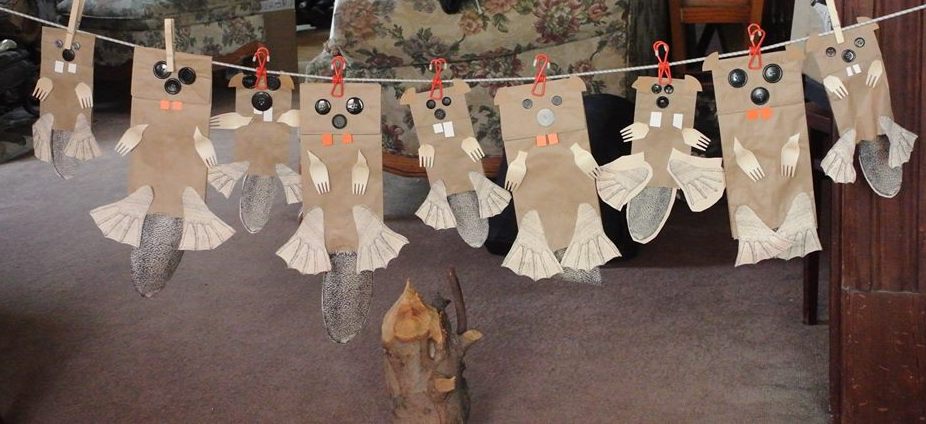Very few beaver tidings really surprise me any more. After 16 years of following their stories I pretty much know the depth and breadth of what to expect anymore. So when I saw a blog from Northern Canada feature our art project from Earthday in 2014 I wasn’t exactly shocked, because it’s a cute photo…until I realized it actually features my living room as well!

The beaver world gathers in tiny Oregon town
“Seventy-five percent of the artificial wetland restoration projects done in America over the past thirty years have failed but when beavers do it, they do it perfectly,” says Stanley Petrowski. He lives in Canyonville, Oregon, a small town in the Klamath Mountains of southern Oregon with a population of 1,660.
Stanley and a neighbour, former logger Leonard Houston, have helped turn the town into the global locus of efforts to restore beavers to their traditional ranges in the wild. They founded the State of the Beaver conference in 2010 after attending a government agency working group where participants spent their time arguing. It’s now in its 13th year.
At that first conference, people from agencies and scientific disciplines who had never met discovered their common interest in beaver ecology. It helped contribute greatly to what some call the ‘beaver enlightenment’.
Interest in beavers has been steadily increasing over the past thirteen years due to the low-cost and extensive benefits to the environment and wildlife that they bring when planted in streams. Water storage, in these times of increasingly frequent drought, is a boon to farmers, ranchers as well as rural towns and cities. Beavers help restore anadromous fish runs and provide homes for waterfowl and aquatic creatures such as frogs and salamanders as well as drinking water for other wild creatures.
This year’s conference, the 13th, will bring together up to 300 beaver restoration advocates and rewilding activists from all over North America and Europe Nov. 13-15, 2023. The theme is “The Path Forward”, focusing on the future of beavers across the northern hemisphere and the best management strategies for both humans and beaver.
Well if my old couch had to find it’s way to one national blog I’m sure happy it showed up on this one! What a perfect way to celebrate 13 years of mind blowing beaver education!
“At no time in history has the plight of the beaver been so illuminated, authors, filmmakers, and the media have shone the international spotlight upon an unlikely hero, the humble hardworking champion of our aquatic ecosystems. Across the Northern Hemisphere beaver ecology is one of the fastest-growing fields in restoration ecology, this event highlights the actions of all whom work in this arena.”
The conference, which is organized by SURCP and sponsored by the National Oceanic and Atmospheric Administration (NOAA), the Maine Community Foundation, and seven other organizations dedicated to beaver restoration, is an economic boon to both the tribe and the small town.
Hundreds of scientists, activists, and lecturers spend time and money in the community. Lodging at the casino and local motels by itself brings in tens of thousands of dollars.
As well as presentations by ecologists, wildlife and fisheries biologists, and activists this year’s conference will feature a panel of representatives from eight East Coast indigenous tribes who will speak of the tradition role of beavers in their culture and about their current restoration efforts.
Leila Phillip, a professor of Environmental Studies at College of the Holy Cross in Worcester, Massachusetts, and author of Beaver Land, How One Weird Rodent Made America, will be the keynote speaker.
Well you know how serious this is because it features my living room on the main page. Who is behind this blog I wonder. I’m not sure I know anyone from Northern Canada. Sounds like someone associated with Cows and Fish don’t you think? That’s Alberta I think…hmm
European visitors are among the participants because restoration efforts for the Eurasian Beaver, a close cousin to the North American Beaver, is a growing field in Britain, Norway, Belgium, Germany, Lithuania and Poland with some of their efforts underway at scales that are often ahead of those in the US.
Sources given include the daily yonder article I featured and shared on the beaver management facebook page as well as the nevada article I shared before that. Then it says the cover photo is from “Worth A Dam”. But just to clarify I haven’t posted that photo in years…
Or sat in that couch for years. Never underestimate the power of cute.







































